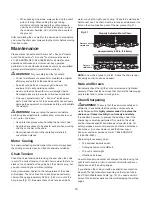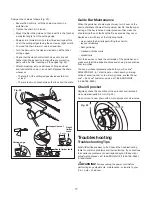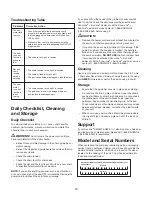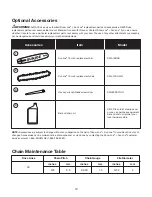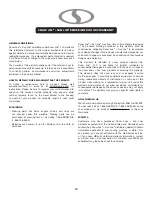
13
Basic Cutting Procedure
This unit is designed for trimming small branches and limbs up
to recommended 7.5 in. (19 cm), not to exceed a max cut of
9.5 in. (24 cm) in diameter depending on type of wood.
Practice cutting a few small limbs using the following
technique to get the “feel” of using the saw before you begin a
major sawing operation.
•
Take the proper stance in front of the tree with the
saw OFF (Fig. 24).
•
Squeeze the trigger and let the chain accelerate to full
speed before entering the cut.
• Keep the saw running the entire time you are cutting;
maintain a steady speed.
•
Allow the chain to cut for you; exert only light downward
pressure. If you force the cut, damage to the bar, chain, or
unit can result.
•
PUSH and PULL –
This reaction force is always opposite
to the direction the chain is moving when it is in contact
with the wood. Thus, the operator must be ready to
control the
PULL
when cutting on the bottom edge of the
bar, and
PUSH
when cutting along the top edge.
•
Do not put pressure on the saw at the end of the cut.
Pruning
Pruning is the process of trimming limbs from a live tree.
•
Remove long branches in several stages.
• Cut lower branches first to allow the top branches more
room to fall.
• When pruning trees, it is important not to make the
finishing cut next to the main limb or trunk until you have
cut off the farthest lying limb. This will reduce the weight
and prevent stripping the bark from the main member.
• Under cut the branch 1/3 through for your first cut.
Your second cut should over cut to drop the branch off
(Fig. 25). Be prepared to balance the weight of the pole
chain saw when the limb falls.
• Now make your finishing cut from the topside of the
branch smoothly and neatly against the main member so
the bark will grow back to seal the wound.
•
Release the trigger ON/OFF switch as soon as the cut is
completed. Failure to follow proper cutting procedures will
result in the bar and chain binding and becoming pinched
or trapped in the limb.
Limbing
Limbing is the process of removing branches from a fallen tree.
•
You should cut limbs one at a time. Remove the cut limbs
from the work area often to help keep the work area clean
and safe.
•
Cut branches under tension from the bottom up to avoid
binding the pole chain saw.
•
Keep the tree between you and the pole chain saw while
limbing. Cut from the side of the tree opposite the branch
you are cutting.
If the Saw Becomes Pinched or Trapped
1.
Wait for the blade to stop, wait five minutes for the saw to
cool, unplug the power cord, and wear gloves to protect
your hands from the chain teeth.
2.
If you can reach the limb from the ground, lift the limb
while holding the saw. This should release the “pinch” and
free the saw.
3.
If the saw is still trapped, call a professional for assistance.
Cutting Tips for Chain Saw
Proper Cutting Stance
• Weight should be balanced with both feet on solid
ground.
• Keep your left arm and elbow locked in a "straight arm"
position to withstand any kickback force (Fig. 26).
• Your body should always be to the left of the chain line.
Fig. 25
Load
Second Cut
First Cut
1/3 Diameter
Finishing Cut
Fig. 26
Chain line
Straight arm
Summary of Contents for SUNJOE SWJ807E-RM
Page 22: ...snowjoe com ...

















